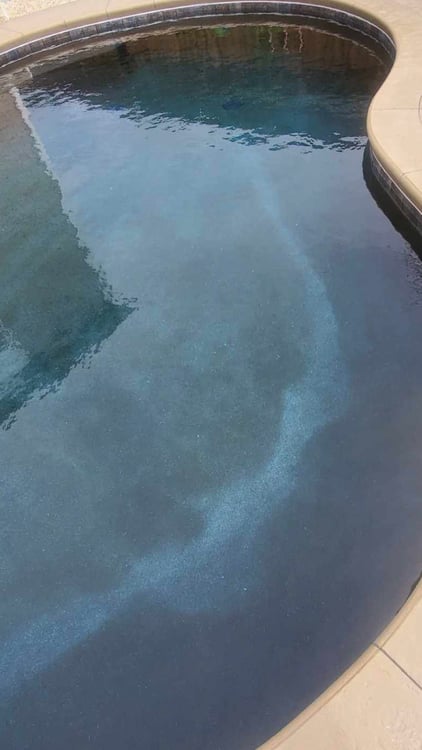Measuring Pool Chemicals Matters for Chemistry and your Wallet

Pool chemistry is a lot like cooking. All the best chefs in the world use measuring cups.
Covered in this article:
- Pool chemistry consequences of not measuring chemicals
- Avoid overcorrections
- Financial consequences of not measuring chemicals
- Conclusion
There are many reasons why measuring chemicals is an important behavior. In this article, we will focus on the two main ones: the pool chemistry itself, and your wallet.
Related: Six Bad Habits in Pool Service
Pool chemistry consequences of not measuring chemicals
Adding chemicals correctly to a swimming pool requires knowing a few things:
- The correct volume of the pool (gallons, liters, etc.)
- The current water chemistry of the swimming pool, and its LSI balance value.
- The correct dose of the chemical you need to add (the proper amount of a chemical to make the desired adjustment)
- How to actually add the chemical to water correctly (like sodium bicarbonate or muriatic acid)
The one thing missing from that list of bullet points is the focus of this article. Measuring. Once you know the pool volume and the current chemistry of the pool, you can use a reference chart (or the Free Orenda App) to find an accurate dose for the chemical you need to add to the water.
Measuring that specific amount of chemical is perhaps the most self-explanatory practice, yet it is widely ignored. Instead, pool owners and operators tend to 'eyeball it' or guess. And sure, with something like liquid chlorine, a few extra ounces won't make a huge difference in a backyard pool. But a few extra ounces of muriatic acid can. And many people are unaware of how significant the difference is.
Take Soda Ash (sodium carbonate) as another example. Soda Ash is about 1200 times more basic than sodium bicarb. It has between an 11.3 and 11.8 pH when added to water, as opposed to sodium bicarb which has 8.3 to 8.6 pH. If not measured and added correctly, Soda Ash is likely to cloud up the pool before your eyes. While people can get somewhat careless and estimate how much bicarb is needed for a swimming pool, Soda Ash should be measured precisely. Otherwise, your pool will cloud up and cause a mess.
Dry vs. Liquid measurements
There is one important distinction worth mentioning here. We also have this as a warning on the dosing results page of the Orenda Calculator™. Dry chemicals are measured by weight, whereas liquids are measured by volume. We discuss this in Episode 157 of the Rule Your Pool Podcast (embedded above in this article).
This means dry chemicals need their own scoop with lines specific to each chemical. One pound of cal hypo is less volume than one pound of diatomaceous earth (DE). Make sure you're measuring dry chemicals appropriately.
Then, like every dry/granular chemical, it needs to be pre-dissolved in a bucket of water prior to being added to the pool.
Avoid Overcorrections
Overcorrecting water chemistry is an everyday problem, and most of us may not even realize it. If you are aiming to raise your alkalinity by a certain amount, but don't measure, you could miss that target. A common example of this is adding too much acid, which lowers the alkalinity more than the planned amount. That over-correction with acid can actually lead to permanent damage (etching or degradation of your fiberglass or vinyl liner pool).
In a plaster-type pool–pebble, quartz, marble dust, or anything else cement-based–the acid will pull out calcium from the surface. This not only negates some of the acid you added to the pool, it also raises pH faster than you had intended. It becomes a vicious cycle, and is arguably the leading cause of discolorations and fading to the bottom of a swimming pool.

In the photo here, you can see where muriatic acid went to the bottom and etched. When it did, calcium was dissolved and drawn out from the cement, which changed its appearance. Some of the calcium that was dissolved took pigment with it, and now there is a white line. This was from pouring acid directly around the perimeter of the pool.
Here is our video on how to properly add acid to a swimming pool:
Financial consequences of not measuring chemicals
Obviously, if you are adding more of a chemical than is needed, you are wasting money. But let's explore this a bit further. As mentioned in the previous section, overcorrections are often more of a financial consequence than a chemistry one. To illustrate this, let's ask a simple question. For a 20,000 gallon (75,708 L) pool, how much muriatic acid does it take to lower the pH from 8.0 down to 7.5?
Most people we ask around the country think it's about half a gallon (64 fl.oz. / 1.89 L). It's actually less than half of that.

That half gallon of is actually overcorrecting the pH well below 7.5. It's taking it down closer to 6.7 pH. Not to mention it took twice the amount of alkalinity out of the water in the process. So now there are two sides to this financial consequence. First, you have to replace the alkalinity to restore a decent level, which means buying sodium bicarb (or in some cases, soda ash). Second, and perhaps more alarming, you are paying for twice the amount of acid that you need.
This is not a hypothetical example either, because we see it almost everywhere we go. This is a very common problem. Pool service companies and homeowners often double their acid costs without even knowing it. Even for a sole-proprietor pool service technician, that could translate to hundreds upon hundreds of dollars in a season. For larger service companies, it's thousands of dollars. Wasted.
Conclusion
Financial and chemical consequences are the two main reasons why measuring pool chemicals are so important. People eyeball chemicals all the time, and it's a bad habit that should be correct. So take a few extra seconds to use the measuring cup, and your pool chemistry will become easier and more affordable to manage.
